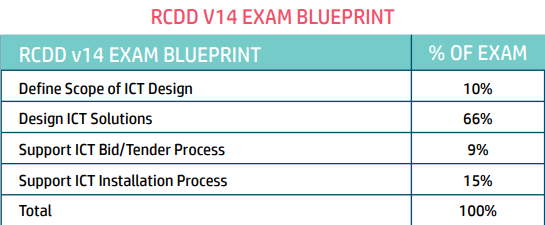New RCDDv14 Dumps [2022] Are Available For BICSI Registered Communications Distribution Designer Exam
Now you can easily boost your understanding BICSI Registered Communications Distribution Designer (RCDDv14) certification exam and enhance your learning preparation with the new RCDDv14 dumps of DumpsBase. We know that the BICSI Registered Communications Distribution Designer (RCDD) designs communications distribution systems, supervises the execution of the design, coordinates activities with the design team, and assesses the overall quality of the completed communications distribution system that supports information and communications technology (ICT) solutions. To earn the RCDD certification, candidates should register for the BICSI Registered Communications Distribution Designer RCDD Version 14 (RCDDv14) exam at Pearson VUE and pass the BICSI RCDDv14 exam successfully. New RCDDv14 dumps of DumpsBase are based on the new BICSI RCDD exam objectives, which are great for passing the BICSI Registered Communications Distribution Designer (RCDD) certification exam.

What is the BICSI Registered Communications Distribution Designer (RCDD)?
BICSI Registered Communications Distribution Designer (RCDD) is issued by the BICSI. The BICSI is a professional association supporting the information and communications technology (ICT) industry. The RCDD certification is critical to building infrastructure development, this program involves the design and implementation of telecommunications distribution systems. Those who achieve the BICSI Registered Communications Distribution Designer (RCDD) designation have demonstrated their knowledge in the creation, planning, integration, execution and/or detailed-oriented project management of telecommunications and data communications technology.
How to achieve the BICSI Registered Communications Distribution Designer (RCDD) certification?
The BICSI Registered Communications Distribution Designer (RCDD) certification requires you to achieve one of the following eligibility options:
Option 1: Two years of verifiable full-time work experience in ICT design AND a current BICSI certification holder as BICSI TECH™, RTPM®, DCDC® or OSP.
Option 2: Two years of verifiable full-time equivalent work experience in ICT design AND completion of two years of higher education course work in ICT. Two years of higher education course work in ICT may include:
● STEM or trade school
● Two-year degree
● ICT and industry-related programs, apprenticeships or certifications
● Military training equivalent
Evidence of completion of higher education course work includes:
● Certificates
● Diplomas
● Registrar’s documentation
● Other bona fide documents
Option 3: Five years of verifiable ICT experience.
Then candidates are required to pass the BICSI RCDDv14 exam successfully. If you are planning to take the RCDDv14 exam, you can come to DumpsBase to choose new RCDDv14 exam dumps to practice all RCDDv14 exam questions and answers to make sure you can pass the BICSI Registered Communications Distribution Designer – RCDDv14 certification exam successfully.
Why choose the DumpsBase BICSI RCDDv14 dumps as the learning materials?
When coming for the BICSI Registered Communications Distribution Designer – RCDDv14 exam, you need to know the RCDD V14 exam objectives as shown:

The new BICSI RCDDv14 dumps of DumpsBase are based on the RCDD V14 exam blueprint. With the help of a trusted source of RCDDv14 dumps for preparation from DumpsBase, the valid RCDDv14 practice questions and answers for exam preparation process becomes easy. The DumpsBase generally gives RCDDv14 dumps to all RCDDv14 candidates for passing the RCDDv14 BICSI Registered Communications Distribution Designer – RCDDv14 exam easily.
To check the quality of new RCDDv14 dumps of DumpsBase, you can check the RCDDv14 free dumps. The free RCDDv14 exam dumps demo of DumpsBase shows the authenticity of its RCDDv14 dumps with its service features. The RCDDv14 students are able to see RCDDv14 practice questions and compare them with the others. Then they will find that the DumpsBase RCDDv14 exam dumps questions and answers are great. So they can choose the Registered Communications Distribution Designer RCDDv14 dumps by paying for it to prepare for the RCDDv14 exam.
You are designing distribution for a seven unit townhouse with in slab conduits.
What is the MINIMUM number of 27 mm (1 in) rigid PVC Type 2 or metallic conduit that is required to satisfy distribution to each unit?
A. Three
B. Four
C. Five
D. Seven
E. Fourteen
Answer: D
You have just finished a design calling for 15 telecommunications outlets. You received word that the owner has increased his requirements by 40%.
What size commercial DD (distribution device) is required to accommodate the increase?
A. 660 mm (26 in)
B. 1015 mm (40 in)
C. 1346 mm (53 in)
D. 1676 mm (66 in)
Answer: C
Which service is NOT typical of Grade 1?
A. Telephone
B. Multimedia
C. Data
D. Television
Answer: B
You are designing a multi-story dwelling and need to place the CTR's. Every floor is not available.
What is the alternate spacing for the CTRs?
A. Every 2 floors
B. Every 3 floors
C. Every 4 floors
D. Every 5 floors
E. 1st floor and midway up through the height of the building
Answer: B
You are designing a system requiring the transmission of data. Your system must perform higher than ________ kHz in order to do so.
A. 4
B. 8
C. 10
D. 16
E. 32
Answer: C
To accommodate telephone, data, CATV, security and multimedia, a MINIMUM of ________ strands of optical fiber auxiliary disconnect outlet (ADO) cable should be provided.
A. Two
B. Four
C. Five
D. Six
E. Eight
Answer: B
Which type of scheduling chart utilizes predecessor and successor relationships when identifying tasks?
A. PERT
B. Calendar
C. Milestone
D. Gantt
Answer: A
Which requirement does the ICT distribution designer provide to the Mechanical Engineer in charge of the HVAC design for a Telecommunication Space?
A. The heat load (BTU (calories/hour) of all equipment installed within the space
B. Location of the telecommunications own dedicated electrical distribution panel
C. The quantity and size of HVAC vents needed for the room
D. Location and size of condensate drain
Answer: A
Which of the following is a consideration for lighting telecommunication spaces?
A. To ensure worker safety within TEs. Light level requirements are higher tor these than other spaces
B. The light fixtures within telecommunications spaces shall be fluorescent type fixtures.
C. The electrical power for lighting shall be connected to the same electrical panel as the telecommunications equipment.
D. The lighting layout shall be coordinated with the equipment and pathway locations
Answer: D
In a budding with one join room for serving as the FR and EF and four dedicated TRs on the same floor a total of__________ 103 mm (4 trade size) conduits should be installed to interconnect the backbone pathways to the ER.
A. 4
B. 8
C. 16
D. 20
Answer: C
What is used to facilitate MINOR changes to the Project Requirements?
Request lot Information (RFI)
A. Punch list
B. Field order
C. Change order
D. Change order request
Answer: C
Which two of the following types of metallic conduit REQUIRE threaded couplings? (Select two options.)
A. Electrical metallic tubing (EMT)
B. Aluminum metal conduit (AMC)
C. Flexible metal conduit (FMC)
D. Intermediate metal conduit (IMC)
E. Rigid metal conduit (RMC)
Answer: D, E
When considering pathway types, the ICT distribution designer should consider the applicable MICE factors as defined in TIA 568 for structured cabling systems and components MICE 3 relates to
A. commercial environment
B. heavy industrial environment
C. medical environment
D. light industrial environment
Answer: A
An ICT distribution designer is representing a client during a project execution.
What is the designer's role in the Vendor and Contractor Coordination?
A. Oversee the sequence of the work and ensure that the job proceeds as anticipated in accordance with the project execution schedule
B. Synchronizes the daily activities of all trades through daily or weekly meetings (depending on project size, complexity, or criticality) with individual trade PMs. Fore people, supervisors and designers as necessary
C. Holds two critical meetings to begin the project and allow all parties to introduce themselves. The first meeting usually is conducted with the owner and design team, and the second meeting is with the field personnel and subcontractors
D. lf specific questions arise regarding coordination of the installation with structural, architectural, and site conditions and work between trades, submit RFIs to the GC with appropriate documentation to demonstrate the concern along with the proposed installation.
Answer: D
An ICT distribution designer is designing a backbone cabling network that is specified for a campus network including several links approaching 2000 m (6562 It) and data rates of 100 Gb/s What optical fiber type(s) should be used?
A. OM3 fiber
B. OM4 fiber
C. Both OS1 and OS2 fiber
D. Both OS2 and OM3 fiber
Answer: C
